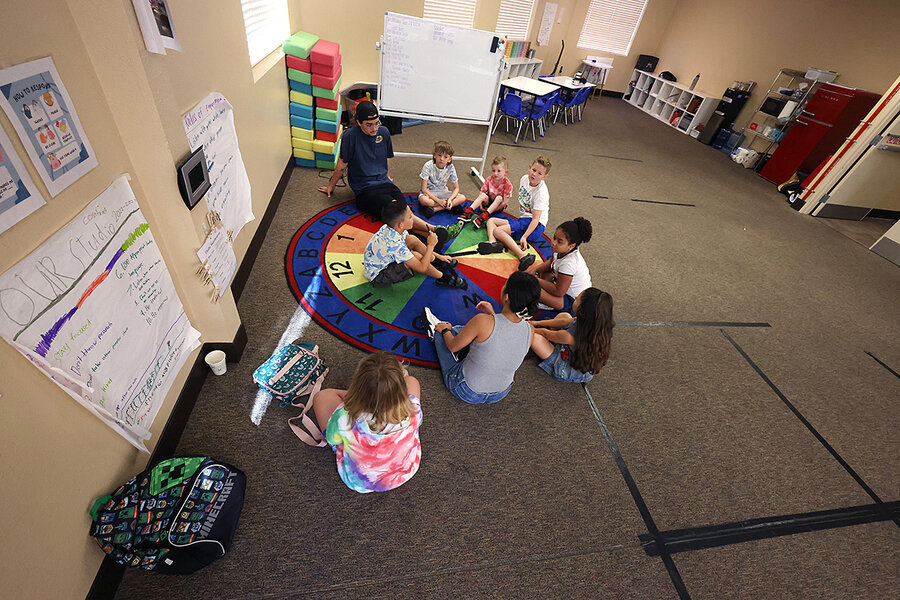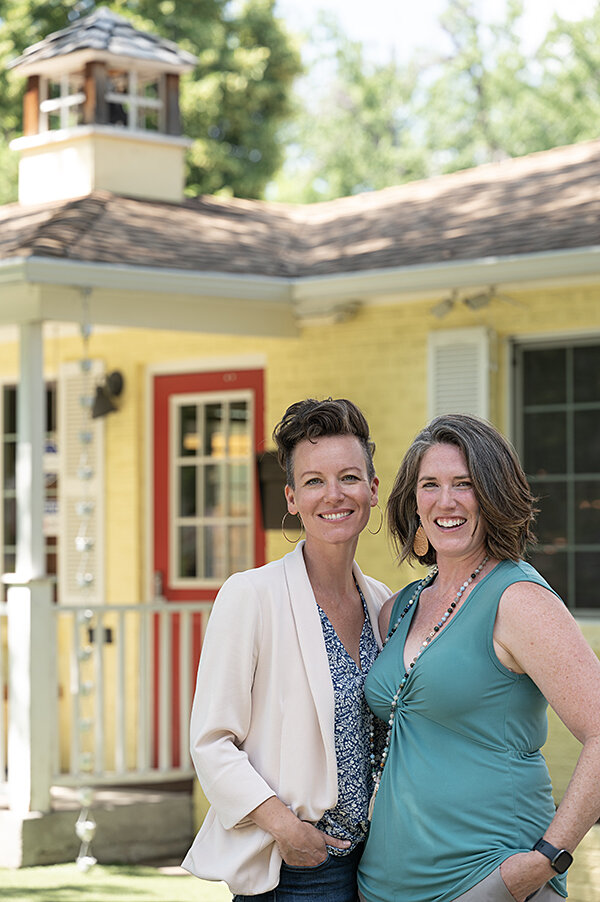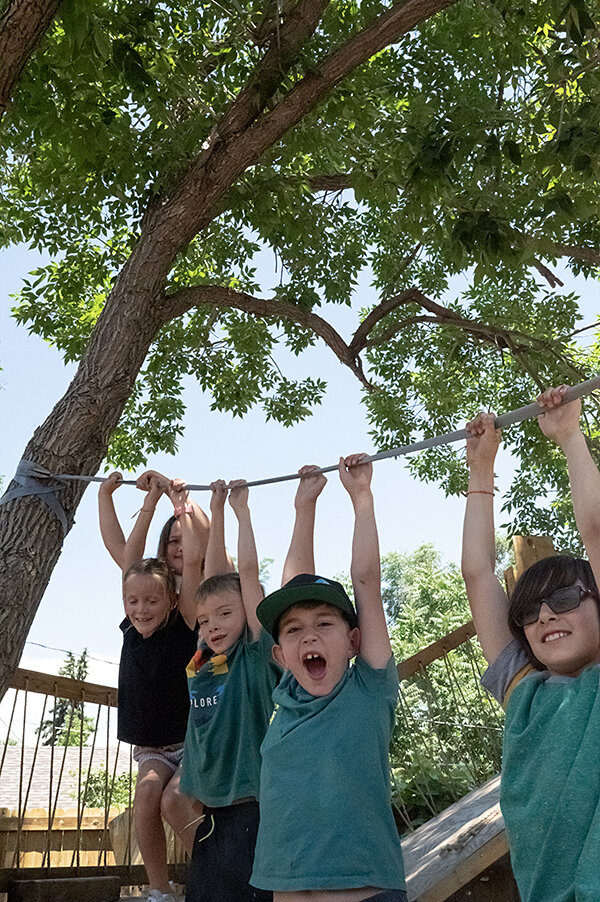Rise of the microschool: Small, student-centered learning spaces take off
Loading...
| Henderson, Nev.; and Denver
Ask a dozen microschool leaders to describe their schools, and you’ll likely receive a dozen slightly different responses: Montessori-inspired, nature-focused, project-based, faith-oriented, child-led, and so on. Microschools do have some things in common, though. They’re intentionally small, typically serving fewer than 30 students total. And they operate as learning centers to support home-schooled students or as accredited or unaccredited private schools.
They’re also ideologically diverse, with microschool leaders and families coming from all different backgrounds, political perspectives, and religious beliefs, says Don Soifer, CEO of the National Microschooling Center.
Why We Wrote This
A story focused onThe one-room schoolhouse is typically considered a relic, but the intimacy and sense of community it represents are making a comeback in today’s microschools.
And while it’s difficult, if not impossible, to pinpoint the exact number of students attending microschools, researchers say it’s likely between 1.1 million and 2.1 million. On the low end, that would mean microschools serve an estimated 2% of school-age children in the United States.
The Highlands Micro School in Denver has 24 students in kindergarten through fifth grade. Students take an assessment three times a year to ensure they’re meeting or exceeding academic standards comparable to their peers in public schools. But proof of concept also comes into play when students age out of Highlands and go on to another school.
Kate Giacomini, who is taking over as the microschool’s director and owner, says she witnessed that firsthand with her son. He joined Highlands as a second grader and graduated to a 600-student public middle school.
“He was able to flourish because he’s really flexible,” she says. “He was given the tools he needed to problem-solve and learn and be confident in his own skin.”
In the back room of a Jewish temple, the kids are running the show.
It’s just after 6 p.m. on a Thursday, and the learners at Life Skills Academy have invited their parents to take a seat. Board games and video games – made by the older children – await the visitors, who, for the next hour, will try them out.
As her classmate gives the go-ahead, 7-year-old Freya Rollinson leads her father and younger brother to a corner. Her exuberant giggles punctuate the directions she’s trying to explain. She says the goal of the game, which features square blocks designated as creatures such as a dog, snake, and unicorn, is to “try not to get tricked.”
Why We Wrote This
A story focused onThe one-room schoolhouse is typically considered a relic, but the intimacy and sense of community it represents are making a comeback in today’s microschools.
“What made you pick all these?” her father, Piers Rollinson, asks.
“My mind,” she replies.
Her answer speaks to the very nature of this learning environment. By Nevada law, Life Skills Academy can’t call itself a school, but education is its mission, albeit in an atypical format. The Montessori-inspired microschool, which rents space at the Jewish temple, served 13 children from age 5 through fifth grade during its inaugural 2022-23 academic year.
But don’t call them students. Here, they’re “learners” who chart their own educational journey through critical thinking and project-based learning. They even make up the classroom rules. The two teachers, known as “learning guides,” take a supporting role in the background.
“We’re building a civil society from scratch,” says James Lomax, founder and director of Life Skills Academy, which is part of the Acton Academy network of microschools. “They, over the course of that first six weeks, make the rules that they live by.”
Most passersby wouldn’t know this place exists. And, in some ways, that’s symbolic of the entire microschooling movement. Tiny learning environments – reminiscent of the one-room schoolhouse – are sprouting in churches, temples, commercial spaces, and even houses across the United States. They’re in bustling cities, rural communities, and suburban enclaves.
Oftentimes, they’re created by parents or teachers who wanted something for their children or students that couldn’t be readily found in traditional schools. But it was the pandemic that thrust this model into the limelight, as families scrambled to make remote learning work. So-called learning pods came into vogue, with kids clustered around kitchen tables, working elbow to elbow with neighborhood pals, relatives, or family friends. The city of North Las Vegas even temporarily ran its own microschools in recreation centers during the pandemic.
Some saw this approach as a Band-Aid solution to a difficult situation. For others, it was just the beginning.
“For lots of people, schools just got too big,” says Michael McShane, director of national research at EdChoice. “They felt like they were a number. They did not feel like they knew the other people in their community.”
Ask a dozen microschool leaders to describe their schools, and you’ll likely receive a dozen slightly different responses:
Montessori-inspired, nature-focused, project-based, faith-oriented, child-led, or some combination of other attributes. They may exist independently, as part of a provider network, or in partnership with another entity such as an employer or a faith organization. Their schedules vary, too. Some follow a typical academic calendar, while others operate year-round, and some allow students to attend part time.
In other words, there is no one-size-fits-all definition for microschools. But, in general, they’re intentionally small learning environments. They often serve fewer than 30 students total and operate as learning centers to support home-schooled students or as accredited or unaccredited private schools. Their exact designations differ based on state laws.
“What I love about microschools is that [they’re] kind of providing this middle ground between public school or home schooling,” says Dalena Wallace, founder and president of Wichita Innovative Schools and Educators, a support network for alternative education models.
The National Microschooling Center launched in August 2022 to support this patchwork quilt of tiny learning communities dotting the American landscape. For a sector analysis released in April, the center examined 100 microschools that exist in 34 states, as well as 100 prospective microschools preparing to open. Though it’s difficult, if not impossible, to pinpoint the exact number of students attending microschools, researchers say it’s likely between 1.1 million and 2.1 million. On the low end, that would mean microschools serve an estimated 2% of school-age children in the U.S.
“I don’t expect that it’s ever going to displace public school systems,” says Don Soifer, CEO of the National Microschooling Center, which is based in Las Vegas. “But it really wouldn’t surprise me if you were to get much closer to a 10% market share.”
The center’s analysis found that although current microschool leaders are predominantly white (64%), that share drops to 55% among prospective founders – indicating a gradually diversifying sector. More than a quarter of those seeking to start their own microschools are Black, and 5% are Latino.
It’s also not an ideologically homogeneous group, Mr. Soifer says. Microschool leaders and families come from all different backgrounds, political perspectives, and religious beliefs. The center’s analysis found that only 27% of microschools offer faith-based instruction.
Kerry McDonald is a senior fellow at the Foundation for Economic Education and author of “Unschooled: Raising Curious, Well-Educated Children Outside the Conventional Classroom.” For years, she has been studying the microschooling movement, which she says dates back to the mid-1990s. That’s when a self-directed learning center in Massachusetts called North Star opened, and hybrid home-schooling programs popped up around the U.S. Ms. McDonald says she has been struck by the cooperation among microschool entrepreneurs who may have very different learning philosophies.
“They come together in the spirit of collaboration and community, sharing knowledge with each other, referring families to each other’s programs, providing resources and encouragement and support,” she says.
But many prospective leaders have one big thing in common: Fifty-two percent are professional or licensed educators, according to the center’s analysis.
Felicia Wright fits that description. A former public school teacher, Ms. Wright founded The Learning Outpost in Las Vegas last year. It was the culmination of a dream that started percolating after her first year of teaching in 2014.
“There’s no way I can do this forever,” Ms. Wright recalls thinking. “This is bananas.”
The workload and emphasis on testing, she says, made the job feel less focused on the children. She hopped from a traditional public school to a charter school but didn’t notice any drastic differences. So she left the field altogether – questioning her teaching chops – and went into marketing. But the tug of the classroom was too strong to ignore. She started an education-related YouTube channel and began tutoring, all of which led friends and family members to nudge her to start her own school.
In 2022, she and her husband took out a $9,000 loan from his retirement account to open The Learning Outpost, which operates out of rented space at a church. When classes began last August, the microschool served four children – two of whom were the Wrights’ own daughters.
“It was a rough go,” she says. “We were running in the red, and I did not have a whole lot of money to sustain this place.”
By October, Ms. Wright made a strategic change to entice more students. She created “flex” scheduling, allowing students to come all day for a minimum of two days a week in addition to the existing full-time option. She announced the flexible scheduling in an email blast, and, within two hours, her phone started ringing. Initially, the surge of interest came from home-school families, Ms. Wright says. As the months progressed, she started welcoming full-time students from private schools whose parents sought a change after noticing their kids’ high stress levels.
Her pitch to parents: “We’re not in a rush here, and kids are on their own journey.”
That journey may look like learning about first aid or purifying water with a solar cell as part of a desert island survival-themed unit. There are no academic standards directly tied to those lessons, Ms. Wright says, but The Learning Outpost weaves in “mini lessons” about more traditional subjects – phonics and math, for instance – throughout the day.
In late June, Ms. Wright toiled in The Learning Outpost, hanging posters and lugging books to different locations. New signage, made by her father, greets visitors at the front entrance. It’s a refresh and reorganization as she preps to begin her second year – this time with an expected 26 students, two teachers, and one executive assistant. She describes her vision come to life as a “microschooling center” or “project-based learning center.”
“I want them to feel at home here,” she says. “That’s important to me.”
In some ways, the microschooling movement echoes a largely bygone time in American education when a little red schoolhouse drew children from the surrounding community. Today, the public one-room schoolhouses that exist typically function out of necessity, serving students in sparsely populated areas.
But the themes inherent in them – multi-age, communal environments with small student populations – have consistently reemerged over the decades as Americans rejected sprawling schools with hundreds or even thousands of students, says Jonathan Zimmerman, an education historian at the University of Pennsylvania.
He points to the open-schools phenomenon in the 1960s, when classroom walls were removed to foster movement and collaboration, followed by a push more recently from policy leaders and philanthropists, including the Bill and Melinda Gates Foundation, to create smaller high schools.
“This image or this metaphor – that’s really what it is,” Dr. Zimmerman says, referring to nostalgia surrounding the one-room schoolhouse, “has something to offer everyone.”
In Denver, it’s a little yellow schoolhouse, though. The Highlands Micro School sits on a leafy residential street about 3 miles northwest of downtown.
Anne Wintemute forged the trail in 2015, well before the term “microschool” had created any dent in the education sphere. At the time, the mother of three was simply looking for a different kind of schooling for her children and had heard that a few small schools existed across the country. She parlayed her business development background into launching the microschool, starting with a hunt for the perfect house. Denver allows educational uses in most zone districts across the city if certain codes are met.
By August 2016, a brown duplex had been transformed into a yellow schoolhouse, complete with a red front door and a cupola containing a bell. A treehouse-inspired play structure built by Ms. Wintemute, a dirt pit for play excavation, and a garage converted into an art studio take up the backyard.
Ms. Wintemute says she built the microschool on an ideological foundation centered around these questions: “What does a school look like if relationships are guiding the decisions? What does it look like to have high standards on an individual level versus the same standards for all? And is it possible to build an educational organization – a school – that serves the needs of the learners?”
Highlands Micro School, considered a private school in the eyes of Colorado, serves 24 students in kindergarten through fifth grade. Ms. Wintemute, who is transitioning out of a leadership role to pursue other opportunities, says the students take a normed assessment three times a year to ensure they’re meeting or exceeding academic standards comparable to their peers’ in public schools. But proof of concept also comes into play when students age out of Highlands and go on to another school.
Kate Giacomini, who is taking over as the microschool’s director and owner, says she witnessed that firsthand with her son. He joined Highlands as a second grader and graduated to a 600-student public middle school.
“He was able to flourish because he’s really flexible,” she says. “He was given the tools he needed to problem-solve and learn and be confident in his own skin.”
Her son’s experience mirrors what Mr. Lomax hoped would be the outcome when he started Life Skills Academy. The U.S. Naval Academy graduate and engineer had encountered a frustrating trend in the workplace: young hires from some of the nation’s top universities who had earned high grades but lacked the ability to problem-solve or navigate human relationships.
Meanwhile, Mr. Lomax and his wife were concerned their daughter’s preschool was more focused on academics than soft skills, such as her ability to make friends and resolve conflicts.
Life Skills Academy aims to foster a learner-directed model where the children chart their own educational trajectory and, in the process, gain leadership, teamwork, and problem-solving skills, Mr. Lomax says. The children move along at their own speed, mastering English language arts and math lessons in the morning before spending the afternoons doing project-based units.
As a kindergartner in 1985, Mr. Lomax says his teacher likely had no idea how the internet would transform future careers. Likewise, with artificial intelligence and other emerging technologies, he says educators can’t fathom the job market for today’s children.
“I can’t prepare them for that, but what I can do is make sure they know how to learn,” he says.
Mr. Rollinson says he saw evidence of that happening in his daughter, Freya, and son, Elliott, after they started attending Life Skills Academy. Instead of coming home anxious, the way Freya had while enrolled at a charter school, she now seems reinvigorated – asking lots of questions and loving to read and write stories.
Freya puts it this way: “We get more free time. There’s no homework. You get to take off your shoes.”
The key to keeping the lights on in a microschool is the same as in any public or private school – money.
Nearly 9 in 10 microschools rely on tuition as their primary source of funding, according to the sector analysis by the National Microschooling Center. About 18% receive state funding provided through school choice programs. Microschools often cobble together other funding streams from fundraising or grants as well.
When Michael Parsons launched the Vandalia Community School in Charleston, West Virginia, last year, he set the microschool’s tuition at $6,800 annually and created avenues for financial aid. He says the rate is lower than nearby private school tuition, a strategic move to make the microschool more accessible.
Mr. Parsons says he is proud that his microschool – which launched with nine children, including two of his own – serves a racially diverse student population as well as both neurotypical and neurodivergent learners. But those equity-minded efforts could go by the wayside if tuition is out of reach.
“We’re always doing our best to kind of fall in that sweet spot where if somebody wants to come to our school, within reason as much as I possibly can, I want to remove money as a deal breaker,” he says.
West Virginia families have a tool at their disposal to help cover that cost: the Hope scholarship. The education savings account program allows families to use state aid – $4,488 per child for the upcoming academic year – for microschool tuition, among other options. Similar programs exist in other states that have passed expansive school choice legislation, such as Florida and Arizona.
As of early June, the West Virginia treasurer’s office had awarded Hope scholarships to 5,099 students, with hundreds more approvals expected this summer. It’s unclear how many of those students are attending microschools, as the money can be directed to everything from tutoring services and textbooks to private school tuition.
Still, the situation has drawn the ire of groups such as the West Virginia Education Association (WVEA), which contends that public schools will be hurt as schools with few, if any, accountability measures receive taxpayer funding.
“Not only are there no restrictions on the educator; there’s no accountability for the students,” says Dale Lee, president of the WVEA, which represents nearly 10,000 educators across the state. “We don’t know if their education is progressing as it should, and yet we’re comparing our public schools and scrutinizing them over test scores when the microschools and learning pods don’t have to have any accountability.”
Some microschool leaders wince at the idea of regulation stymieing creativity. They argue their accountability comes in the form of a contract with the parents who enroll their children. Depending on the microschool, those academic measures of progress could take the form of occasional testing, a portfolio review of a student’s work, or something else entirely.
Ms. Wallace, of the Wichita Innovative Schools and Educators support network, says she anticipates greater regulation if microschools accept public money, but if they’re relying solely on tuition and private funding, she believes they should be granted more freedom. Her own six children, whom she home-schools, attend a microschool one day a week in rural Abbyville, Kansas. The arrangement provides variety during the week, she says, and also “helps keep it sustainable for families that need a little bit of additional support.”
Ultimately, Mr. McShane, of EdChoice, expects more attempts to regulate microschools as the sector expands. A hint may lie in how states handle home-schoolers.
“There’s a wildly different home-schooling regulatory environment from state to state,” he says. “And I imagine something similar will probably happen with microschools.”
Regardless of whether state money is available to parents, microschool leaders are tapping into private funding sources to make ends meet.
In Las Vegas, Ms. Wright received three grants totaling $52,000 for The Learning Outpost during one week last year. “Those opportunities make a big difference” for small enterprises operating on thin margins, she says.
A powerhouse in the grant-making arena is the VELA Education Fund, which gives money to “everyday entrepreneurs in unconventional education.” Since 2019, the nonprofit fund – whose board members include representatives from the Walton Family Foundation and Stand Together Foundation – has distributed more than $24 million, some of which has gone to microschool leaders.
A report released by VELA this year notes that 93% of its grantees serve children whose families identify as low income or historically underserved, with 38% focusing on those student populations.
No matter how microschools are financed, Dr. Zimmerman considers quality monitoring a civic responsibility given the need for an educated populace.
“It’s not just about these people,” he says. “It’s about all of us. And so they should be allowed and encouraged to innovate, but the rest of us should be watching closely.”
Mr. Parsons, from West Virginia, doesn’t see microschools fizzling out as a fad. Down the line, he even envisions an education landscape where school choice isn’t seen as a divisive concept.
Could microschools forge partnerships with nearby public schools? He thinks yes. In an ideal world, Mr. Parsons says microschool students could participate in sports or extracurricular activities at public schools. Conversely, students struggling in larger public school settings could be referred to microschools.
“I hope to see this become something [in which] the adults are behaving like adults, and we’re talking and we’re collaborating,” he says. “The students benefit from that.”

















